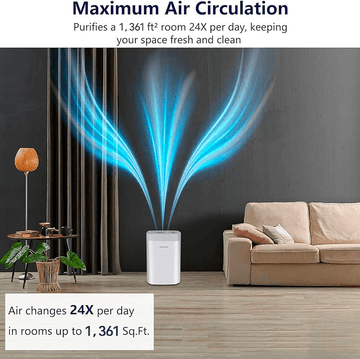Clean air is a precious commodity, and home air purifiers have become stalwarts in the battle against indoor pollutants. The question often arises: Is it beneficial to keep your air purifier running 24/7, especially during the night? In this comprehensive guide, we'll unravel the mysteries surrounding continuous air purifier operation, examining the potential advantages and pitfalls. Armed with facts and expert insights, you'll be equipped to make an informed decision about the optimal usage of air purifiers for the home.
Benefits of Continuous Operation:
Running your air purifier throughout the night can offer several notable benefits. First and foremost, it ensures a consistent level of air quality in your home. Airborne particles, allergens, and pollutants don't adhere to a strict schedule, so maintaining purification during nighttime hours helps combat their presence effectively. This continuous operation is particularly advantageous for individuals with respiratory conditions or allergies, providing a continuous shield against potential triggers.
Moreover, some air purifiers are designed to operate quietly, making them suitable for bedroom use. By choosing a model with a noise level conducive to sleep, you can enjoy cleaner air without sacrificing a peaceful night's rest.
Using the Nuwave OxyPure Zero air purifier as a prime illustration, it incorporates a quiet DC motor, guaranteeing a peaceful atmosphere around the clock. Once in Sleep mode, it tactfully dims all indicator lights and provides adjustable fan speeds, fashioning an idyllic setting conducive to a profoundly restful night's sleep.
Considerations and Potential Drawbacks:
While the benefits are compelling, there are factors to consider before leaving your air purifier on all night. Energy consumption is a critical consideration, as continuous operation can lead to higher electricity bills. It's essential to assess the energy efficiency of your device and weigh it against the potential costs.
Present-day smart air purifiers showcase advanced features like Energy Saver Mode, utilizing air quality and odor sensors to identify pollutants. They possess the capability to manually or automatically eliminate these contaminants from the air. Operating through convenient modes such as Auto Mode and Ultimate Clean Mode, these intelligent purifiers ensure efficient and targeted purification.
Additionally, not all air purifiers for the home are created equal. Some models may release ozone, a potential lung irritant, into the air. Understanding the specific features and potential drawbacks of your purifier is crucial to ensuring its safe and effective operation.
Best Practices for Nighttime Purification:
For those committed to maintaining clean air throughout the night, adopting some best practices can optimize the experience. Consider placing the air purifier strategically in the bedroom to maximize its impact. Regularly changing and cleaning the filters is another key aspect to ensure optimal performance. Here are some help tips for creating a healthier indoor environment.
-
Invest in a Quality Air Purifier:
- Choose an air purifier with HEPA filters to effectively capture particles like dust, pollen, and pet dander. Look for additional features such as activated carbon filters to tackle odors.
-
Maintain Indoor Plants:
- Incorporate indoor plants like snake plants, spider plants, and peace lilies to naturally improve air quality by absorbing pollutants and releasing oxygen.
-
Proper Ventilation:
- Ensure good ventilation by regularly opening windows and doors to allow fresh air to circulate. This helps reduce indoor pollutants and prevents the buildup of stale air.
-
Control Humidity Levels:
- Keep humidity levels between 30-50% to prevent the growth of mold and dust mites. Consider using a dehumidifier in damp areas like basements.
-
Regular Cleaning:
- Dust and vacuum regularly to minimize dust mites and allergens. Clean bedding, curtains, and carpets frequently, and use a vacuum cleaner with a HEPA filter.
-
Avoid Harsh Cleaning Chemicals:
- Opt for eco-friendly and non-toxic cleaning products to reduce exposure to harsh chemicals. Consider natural alternatives like vinegar and baking soda.
-
Mindful Furniture Selection:
- Choose furniture made from low-emission materials to minimize the release of harmful chemicals into the air. Look for products labeled as eco-friendly or GreenGuard Certified.
-
Create a Shoe-Free Zone:
- Designate an area near the entrance for removing shoes to prevent tracking in pollutants and outdoor contaminants.
In conclusion, the decision to run your air purifier all night depends on various factors, including your specific needs and the features of your device. By weighing the benefits and drawbacks, you can create a healthy indoor environment tailored to your lifestyle.

